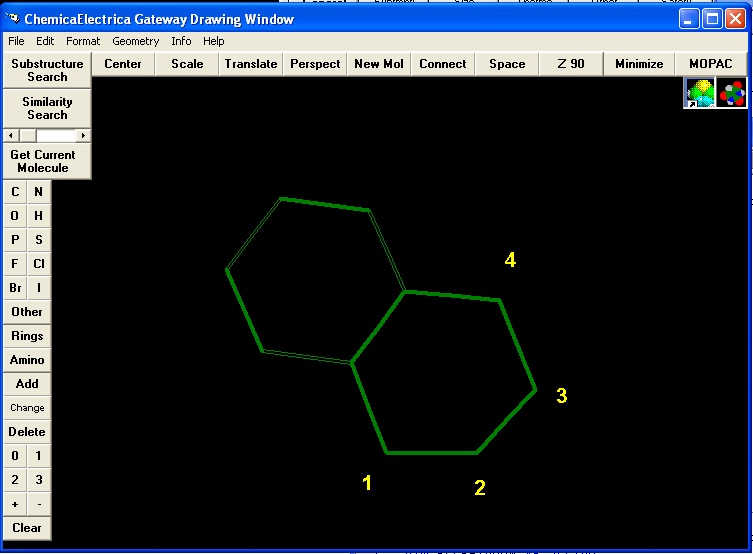
1. Drawing the tetracycline ring system with stereochemistry
| a. In the Drawing Window click on the Rings button and select tetralin off the list of rings that appears. The following rings are displayed: | ||
 |
||
b. Rotate the molecule by holding down the right mouse button near the bottom of the screen until the molecule is nearly flat, but none of the atoms is obscured. Since this molecule has stereochemistry we want it nearly flat so we can see the up and down bonds.
c. Now we are going to add atoms to the non-aromatic ring. Click on the "O" button and the "2" button then click on carbon number 1 in the above drawing to add a double bonded oxygen. Click on the "C" button and carbon number 2 above to add double bonded carbon. Add hydrogens to all the positions by double clicking on the H button. Delete the hydrogen pointed up on atom number 3 by clicking on the Delete button and on the hydrogen pointed up. Click on the Add button, click on the C button, click on the "1" button and click on carbon atom number 3 to add carbon pointed up to atom 3. Click on the Change button. Click on the hydrogen pointed down on atom number 4 to change it to carbon. Click on the O button, then click on the hydrogen pointed up on atom number 4 to change it to oxygen. You should now have the following drawing:
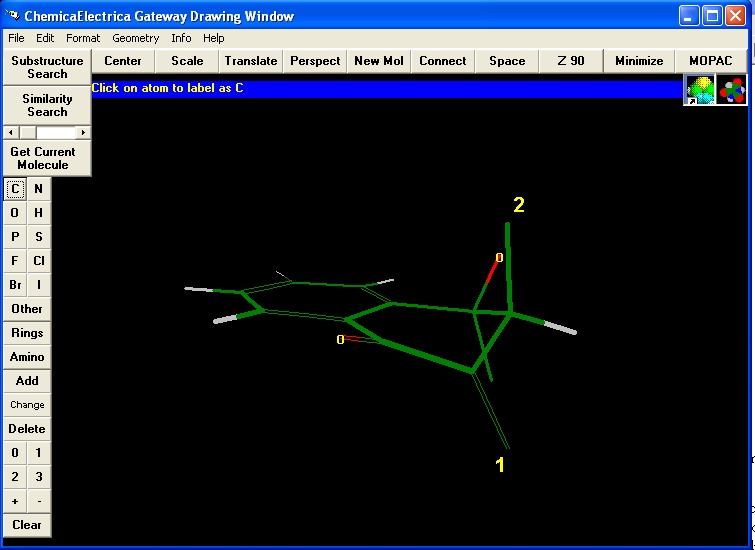
d. Now we will draw the third ring. Double click on the H button to add hydrogens. Hit the Change button. Hit the C button. Click on the hydrogen attached to carbon atom 1 that is pointed more up to change it to carbon. Click on the hydrogen atom attached to atom 2 that is closest to the carbon attached to atom 1. Click on the 1 button. Click on the Connect button. Click on the two new carbon atoms you just created to connect them and close the ring. Double click on the H button to add hydrogens. Click on the Minimize button and select the Standard MM2 minimization. A drawing like the next one should appear.
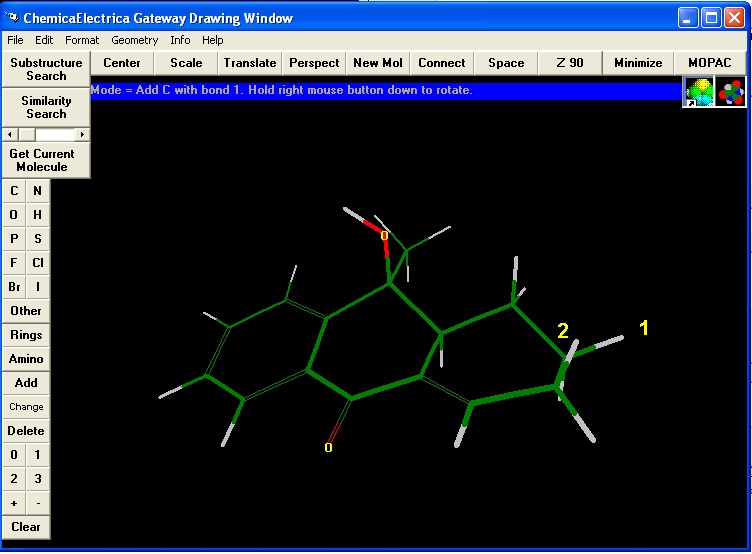
e. Now we will add the fourth ring. The two hydrogens labeled 1 and 2 in the above drawin will be changed to carbon. Hit the Change button then click on the atoms labeled 1 and 2. Double click on hydrogen to add them to all atoms. Hit the Change button again. Click on a hydrogen in each of the two newly created carbon atoms to put the new ring in a "chair" conformation. Click on the 2 button. Click on the Connect button. Click on the two last created carbon atoms to close the ring. Double Click on H to add hydrogens to all atoms. Click on the Minimize button and choose "Normal MM2." If the MM2 program does not return a molecule with some of the H atoms in obviously bad geometries, delete all hydrogens by double clicking the Delete button. Then add the hydrogens back by double clicking on the H button and minimize the molecule again. You should get a drawing that looks like the following picture:
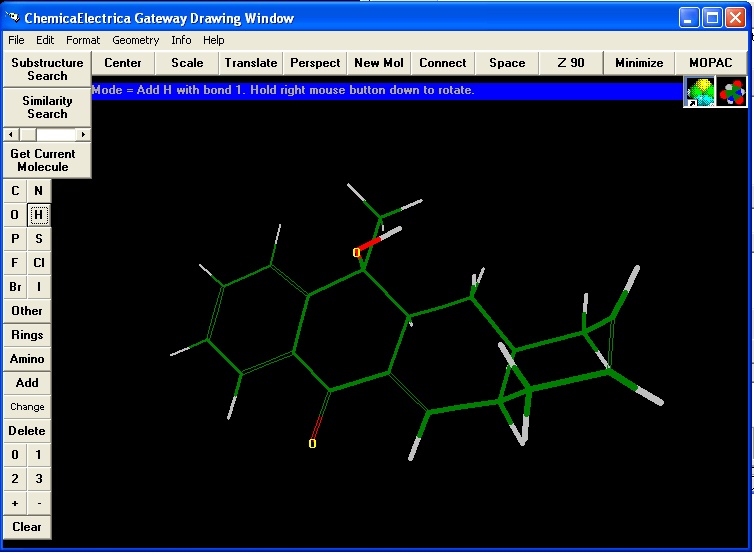
f. This is the tetracycline ring system. To complete the molecule use the change, delete and add buttons to add the atoms of the ring substituents.
2. Drawing the sirolimus ring system with stereochemistry.
a. Click on the Ring button. Click on the 2-D generic button. Type in 29 and click on done. A flat single bonded 29 atom ring will appear. Rotate it to about 30 degrees from flat. Double click on H to add hydrogens to all atoms. Click on delete. Click on all of the hydrogens on six consecutive atoms. A molecule resembling the picture below appears:
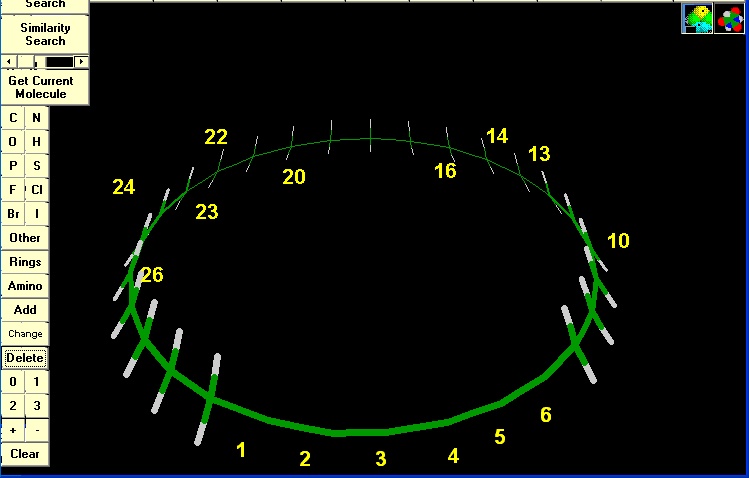
b. Change the bonds between atoms 1 and 2, 3 and 4, and 5 and 6 to double bonds. Click on the Change button then click on the 2 button. Click on atom 1 then click on atom 2. Repeat this procedure (starting with the Change and 2 buttons) for the other two bonds.
c. Delete the hydrogens from atoms 10, 13, 14, 16, 20, 22, 23, 24, and 26.
d. Hit Change and click on O. Click on Atom 26 to change it to oxygen.
e. Hit Change and click on N. Click on atom 22 to change it to nitrogen.
f. Hit Add, click on O and click on 2. Click on atoms 10, 16, 20, 23 and 24 to add double bonded oxygen to each of these atoms.
g. Click on Change and two, then click on atoms 13 and 14 to change a single bond to a double bond.
h. We will now build a six membered ring fused to the large ring. Click on Add, then click on C, and then click on the 1 button. Click on the nitrogen (atom 22) in the ring. Delete the hydrogen pointed up on atom 21. Click Add then click on atom 21 to add a carbon to it. Add another C to one of the new C atoms. Rotate the new atom if necessary using the Geometry menu and clicking not on this atom but on the atom it is attached on and the atom that that atom is attached to. Add a C to the carbon attached to atom 21 and rotate this atom if necessary. Click on the Connect button and close the ring.
i. We will now build a second six membered ring fused to the 29 atom ring. Delete the hydrogen pointed up on atoms 25 and 27. Click on Add and click on atoms 25 and 27 to add a carbon. Click on one of the new carbon atoms to add the sixth atom of the ring. Rotate the new atom if necessary. Close the ring with the Connect button.
You should have a ring system that looks like this:
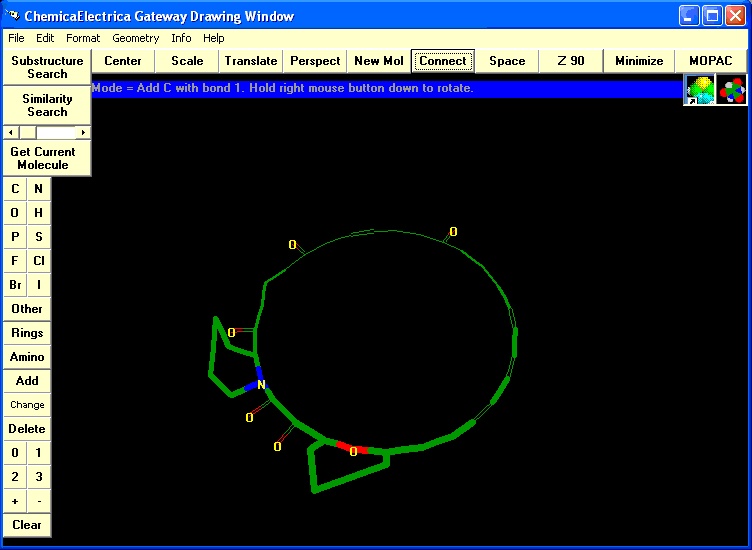
j. Double click on the H button to add hydrogens, the click on the Minimize button and a.select Global Minimization. Delete the hydrogens (double click the Delete button) then minmize again. You will have drawn the Sirolimus ring system.
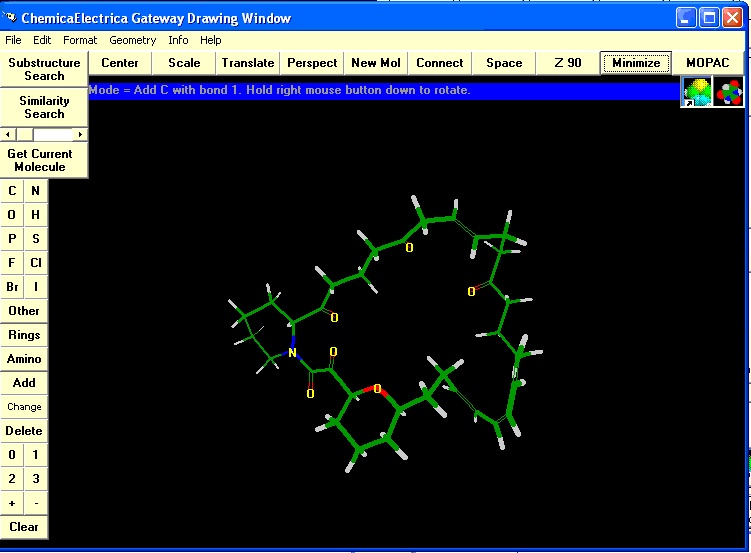
You can complete the molecule by using the Delete, Add, Change and Ring button to add the ring substituents. If the geometry is not to your liking you can use the Move atom feature of the Geometry menu to move individual atoms around manually and then Minimize again.